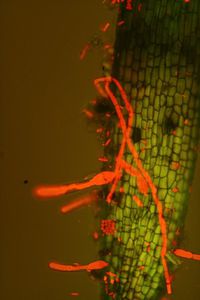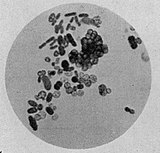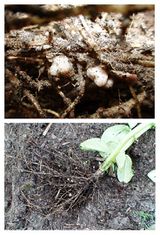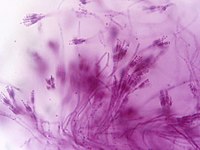Micro-organisms in the soil
- Topic in Gardening courses. By John Eagles.
Provided there is a carbon source, microorganisms exist in large numbers in the soil. There are more microbes in a teaspoon of soil than there are people on the earth. For example, there are 100 million to a billion bacteria in one gram of soil and 100,000 to a million fungi. Their biomass per m2 is for bacteria 40-500 g and for fungi 100-1500g at 0–6 inches (0–15 cm) depth of soil.[1]
Most of the soil microbes tend to be in a dormant state, the more so in tilled soils. Soils that haven't been tilled for a longer time have significantly greater levels of microbes. What microbes need as food are dead plant residues and plant nutrients.
Soils contain soil organic matter. Soil organic matter is composed of:
- living microorganisms,
- dead residues of plant and animal material,
- and the organic material that is resistant to decomposition and that may be thousands of years old (which we call 'humus.')
Microorganisms need regular supplies of new organic material in order to survive.
Microbes grow faster in warmer temperatures. This is why in the tropics we find little or no humus in the soil. Most of the carbon is tied up in above-ground vegetation. In regions with high temperatures and enough moisture, microbes quickly decompose soil organic matter. In colder regions soils contain much larger amounts of soil organic matter.
In acid soils microbes are less effective in decomposing organic material. This is why liming soils often enhances decomposition and more nutrients for plants become available.
Organic material that has been made finer will more easily be decomposed by microbes because the surface area is bigger for finer particles.
Grassland generally forms much organic material in the soil because 50 percent of the grass roots dies each year. This is why agricultural soils of former prairies with thick layers of humus formed in the past are very productive. These soils also contain more microbes and larger fungal populations.
Soils inhabit several groups of microorganisms, but the most important amongst them are: bacteria, actinomycetes, fungi, algae and protozoa. In addition to these groups, also the micro-animals (nematodes and rotifers) are explored below.
Rhizosphere
The rhizosphere is the narrow region of soil that is directly influenced by root secretions and associated soil microorganisms. The rhizosphere typically contains 1000 to 2000 more microorganisms than soil without roots.
"The rhizosphere contains many bacteria that feed on sloughed-off plant cells, termed rhizodeposition, and the proteins and sugars released by roots. Protozoa and nematodes that graze on bacteria are also more abundant in the rhizosphere. Thus, much of the nutrient cycling and disease suppression needed by plants occurs immediately adjacent to roots."[2]
Bacteria
Bacteria exist in large numbers in the soil. Because their size is small they have a rather small biomass compared to other soil microorganisms.
Aerobic and anaerobic bacteria
Bacteria that need oxygen for their survival are called aerobic bacteria and bacteria that do not require oxygen for survival are called anaerobic bacteria. Anaerobic bacteria may die if kept in an oxygenated environment. They can be found deeper into the soil, inside soil particles and also deep in the ocean.
The differentiation between aerobic and anaerobic bacteria is important for how we treat the soil. Aerobic bacteria live closer to the surface and anaerobic bacteria deeper. In general when we cultivate a soil it is preferable to not disturb the soil layers too much and keep above what's up and keep down what's below. This is why most organic gardeners don't plow or dig a soil but don't cultivate it all (only cover the soil with mulch) or cultivate it with a pin similar to how plowing was done in the ancient past.
The nitrogen cycle
- Main article: Nitrogen cycle. See also Some science for the gardener, section Nitrogen cycle.
Nitrogen in the air becomes a part of biological matter mostly through the actions of bacteria and algae in a process known as nitrogen fixation. These bacteria (and algae) take nitrogen from the air and convert it into ammonia (NH3). Other bacteria transform ammonia into nitrite ions, NO2- and then nitrate ions, NO3-. Plants use the nitrate ions as a nutrient.
Some bacteria that make nitrogen from the atmosphere available to plants are Azotobacter, Cyanobacteria and Rhizobium, .
Other bacteria (not specified below) are those that convert nitrates back to nitrogen gas in a process called denitrification.
Azotobacter
Azotobacter is a genus of usually motile bacteria. They are aerobic, free-living soil microbes which play an important role in the nitrogen cycle in nature. They bind atmospheric nitrogen, which is inaccessible to plants, and release it in the form of ammonium ions into the soil. It is also used for the production of biofertilizers. Azotobacter is found in neutral and alkaline soils, in water and in association with some plants.[3]
Cyanobacteria
Cyanobacteria, also known as blue-green algae, are bacteria that obtain their energy through photosynthesis. Cyanobacteria can be found in almost every terrestrial and aquatic habitat. Aquatic cyanobacteria are probably best known for the colored clouds that can form in waters and have the appearance of blue-green paint.
Because they are bacteria they are small and usually unicellar, but they often grow colonies big enough to see.
Cyanobacteria are at the origin of plants. The chloroplast with which plants photosynthesize food is actually a cyanobacterium living inside the plant's cells.
Some cyanobacteria species are specialized for nitrogen fixation and are able to fix nitrogen gas into forms that can be absorbed by plants. Nitrogen-fixing cyanobacteria are for example used to fertilize rice plants.
Rhizobium
Rhizobia are soil bacteria that fix nitrogen inside root nodules of legumes (Fabaceae), such as clover and beans. Each of these nodules contains billions of Rhizobia bacteria. The photo shows root nodules of the fava bean.
Actinobacteria
Actinobacteria or actinomycetes have characteristics that are common to both bacteria and fungi. Like bacteria they are unicellular, but they also form a mycelium from hyphae.
Actinomycetes are abundant in soil and compost. Actinobacteria appear 10 times smaller in number in soils compared to bacteria but because they are larger in size, their total biomass is similar. They count from 10,000 to 100 million per gram of soil.
Actinobacteria are aerobic and can grow fast in compost and manures at temperatures of 55-65 C. They don't multiply well under acidic conditions but require a pH range of 6.5 to 8.0. They also don't thrive in waterlogged soils.
They decompose organic substances such as cellulose, polysaccharides etc. They are slower in activity and growth than bacteria and fungi, so organic residues are first decomposed by bacteria and fungi and later by actinobacteria. But they do degrade the more resistant organic matter and produce dark black to brown pigments that is the characteristic of humus. They also further decompose humus that is already longer in the soil. They are responsible for the earth smell of freshly plowed soils.
Many actinobacteria species produce a number of antibiotics.[4]
Fungus
Fungi include microorganisms such as yeasts and molds as well as mushrooms. Although fungi are smaller in population numbers, they dominate the soil biomass in undisturbed soils. Bacteria, actinomycetes and protozoa can tolerate more soil disturbance and therefore dominate in tilled soils. Fungal populations tend to dominate in untilled soils.
Normally we see little or nothing of fungi except when they form fruits such as mushrooms and molds. Fungi play an essential role in nutrient cycling and exchange. They are also used directly as source of food, such as truffles and edible mushrooms. They can be a leavening agent for bread and are used to ferment wine, beer, soy sauce. Fungi have also been used for the production of antibiotics. These antibiotics grow naturally in healthy soils, see the section below 'Penicillium.'
Mycorrhizae
- Main article: Mycorrhiza
A mycorrhiza[5] is a symbiotic (generally mutualistic, but occasionally weakly pathogenic) association between a fungus and the roots of a higher plant. In a mycorrhizal association, the fungus colonizes the host plant's roots, either intracellularly or extracellularly. They are an important component of soil life.[6]
Mycorrhiza literally means “fungus-root”. The hyphae or the microscopic filaments of a fungus penetrate the root of a plant. The hyphae form a network or mycelium in the soul around the root. This greatly increases the plant's ability to absorb water and minerals. The fungus shares water and minerals with the plant and the plant shares carbohydrates produced by photosynthesis with the fungus. Some plants are very dependent on the minerals they receive from the fungus, for example some plants are entirely dependent to receive phosphorous in this way.[7]
Penicillium
Penicillium is the largest group of fungi in soils. Members of the genus produce penicillin, a molecule that is used as an antibiotic, which kills or stops the growth of certain kinds of bacteria inside the body. Penicilliums form a mycelium that typically consists of a highly branched network of usually colorless hyphae.
Penicillium is normally nonpathogenic with some exceptions.
Penicillium bilaiae is an example of a Penicillium that can be used as a plant growth-promoting microorganism. The organism can live in symbiosis with several plant species by enhancing phosphate uptake by the root structure while feeding off plant waste products. Native soil populations are often low and can be increased by inoculating soils with this fungus.[8]
Penicillium roqueforti is widespread in nature. It can be isolated from soil, decaying organic matter, and plants. It is used for the production of blue cheeses.[9]
A healthy soil produces antibiotics which fight soil-borne diseases.
Yeasts
Yeasts are fungi, with 1,500 species currently described. Yeasts are unicellular, although some species form strings of connected budding cells. Yeasts are used in dough for bread and in wine and beer to produce alcohol and carbon dioxide. Also soils contain yeasts. All yeasts need oxygen, so they do not grow in soils or soil layers that are depleted of oxygen.
Yeasts occur naturally on the skins of fruits and berries, such as grapes, apples or peaches. Yeasts are also present in the gut flora of mammals and some insects. For example several species of yeasts colonize the nectaries of flowers and honey stomachs of bees.[10]
Molds
Molds are fungi that grow as multicellular filaments called hyphae. A connected network of these tubular branching hyphae is a mycelium and a single organism. The mycelium appears as very fine, fluffy white threads over the surface. The dust that is given off are spores.
Molds are considered to be microbes. They decompose natural materials. Some diseases of animals and humans are caused by toxins formed by molds or by allergic reactions to spores.[11]
Algae
Algae range from unicellular to multicellular forms, such as the giant kelps that grow to 65 meters in length. Nearly all algae photosynthesize like plants. They are simple in the sense that their tissues aren't organized such as those in land plants. The largest and most complex forms are called seaweeds.
Algae are defined in such a way that they always have a nucleus enclosed within a membrane (eukaryotic organisms).
Algae produce oxygen as a by-product of photosynthesis.
Some species of algae form symbiotic relationships with other organisms. In these symbioses, the algae supply organic substances and energy and the host organism gives protection to the algae. These other organisms are lichens, coral reefs and sea sponges.[12]
The spores of algae are everywhere on the earth, in fresh and marine waters, in the atmosphere, in precipitation, in humus and in animals and humans. The spores are mainly dispersed by running water, wind and living carriers.
Algae in the form of seaweed is used to fertilize soils in many regions of the earth.
Protozoa
Protozoa are unicellular animal-like organisms. Many of them are motile. They are larger than bacteria and size from a few microns to a few centimeters. Their population in arable soils range from 10,000 to a million per gram of soil. They are abundant in surface soil.[13]
Most protozoans feed on or ingest soil bacteria. Protozoa play an important role in maintaining microbial stability in the soil. Some protozoa have been used as biological control agents against phytopathogens(organisms that are parasitic on plant hosts).
Several soil protozoa can cause diseases in human beings, for example Amoebic dysentery.
Micro-animals
Micro-animals are animals that are microscopic and cannot be seen with the naked eye. Mostly these microorganisms are multicellular.
Nematodes
Nematodes or roundworms are the most diverse phylum of all animals. They are very difficult to distinguish. The total number of species is estimated to be about 1 million.
Nematodes have tubular digestive systems with openings at both ends. Like fungi they are more present in untilled than in tilled soils. They inhabit nearly every ecosystem on earth, from marine to fresh water, to soils, and from the polar regions to the tropics. They represent, for example, 90 % of all life forms on the ocean floor. They can number more than 1 million individuals per square meter.
Nematodes may be beneficial or detrimental to plant health, this depends on the species. There exist predatory nematodes that kill garden pests like cutworms and pest nematodes. Various species feed on algae, fungi, fecal matter, dead and living organisms. They play an important role in the decomposition process.[14]
Rotifers
Most rotifers, also called wheel animals, are around 0.1-0.5 mm long. They are common in freshwater environments with a few saltwater species. Rotifers are an important part of freshwater zooplankton and they also contribute to the decomposition of soil organic matter. They eat dead bacteria, algae and protozoans. They are used in fish tanks to help clean the water.[15]
See also
References
- ↑ Understanding Soil Microbes and Nutrient Recycling - The Ohio State University
- ↑ Rhizosphere - Wikipedia
- ↑ Azotobacter - Wikipedia
- ↑ Soil Microorganism – Actinomycetes - My Agriculture Information Bank
- ↑ See Botany for gardeners by Brian Capon, chapter 6
- ↑ Mycorrhiza - Wikipedia
- ↑ A plant's best friend, by Gerry Barclay (pdf)
- ↑ Penicillium bilaiae - Wikipedia
- ↑ Penicillium roqueforti - Wikipedia
- ↑ Yeast - Wikipedia
- ↑ Mold - Wikipedia
- ↑ Algae - Wikipedia
- ↑ Soil Microorganism – Protozoa (My Agriculture Information Bank)
- ↑ Nematode - Wikipedia
- ↑ Rotifers - Wikipedia
External links
- BENEFICIAL AND EFFECTIVE MICROORGANISMS FOR A SUSTAINABLE AGRICULTURE AND ENVIRONMENT Dr. Teruo Higa and Dr. James F. Parr, Japan 1994 (EM - Effective Micro-organisms)
- Cyanobacteria Wikipedia
- Mycorrhiza Wikipedia
- Rhizobia Wikipedia
- Root nodule Wikipedia
- Soil biomantle Wikipedia
- Soil life Wikipedia
- The role of soil bacteria The Ohio State University
- Understanding Soil Microbes and Nutrient Recycling The Ohio State University
Advised reading for in-depth information
Videos
Books
- Soil microbiology (1952) Author: Waksman, Selman A. (Selman Abraham), 1888-1973; 380 pages














